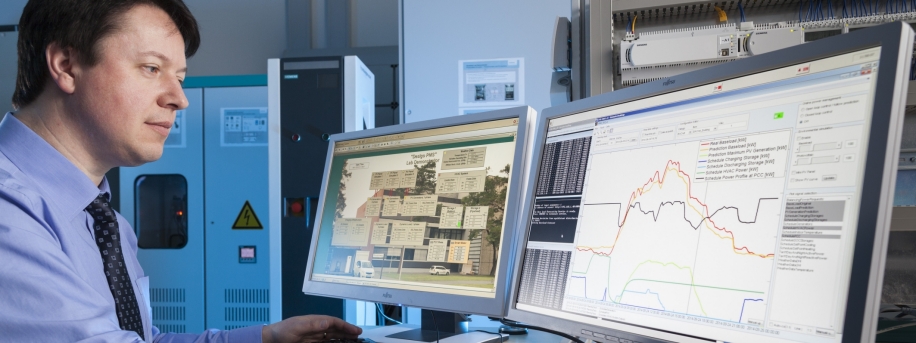
Microgrids Transforming America’s Power Network Efficiency

Siemens' smart Microgrid Management System integrates and optimizes decentralized power generation assets and controllable loads to ensure enablement of energy infrastructure functionality
Siemens is working with customers in the United States to move generation closer to load sources, increasing distributed energy sources on the grid. Many large energy users – military bases, universities, commercial campuses, etc – are looking to invest in on-site generation and infrastructure due to the significant value of increased resiliency and energy security of having their power source nearby that they can control independently from the serving utility.
Microgrid design and software control easily integrates and optimizes existing energy infrastructure, renewable generation, and load sources while providing a scalable infrastructure for future expansion.
Siemens is demonstrating their commitment to distributed energy and Microgrid development through their 17 awards with New York State’s Microgrid grant program. Governor Cuomo has dedicated over $30Million dollars to fund community energy resiliency Microgrid projects throughout the state.
In the first phase of the award, Siemens is investigating the technical and economic feasibility of microgrids in cooperation with partners, consulting firm Booz Allen Hamilton and the software company Power Analytics. These smart electricity networks are being evaluated in order to provide communities with a cleaner, more reliable and more affordable energy supply.
Microgrids are More Flexible and Easier to Regulate
The U.S. has a total of about 10.6 million kilometers of power lines, some of which are nearly 100 years old. That’s more than five times longer than the grid in Germany, which has around 1.8 million kilometers of power lines. Monitoring and ensuring the stability of large power grids is very time-consuming and expensive, and the costs are ultimately borne by the customer. Isolated microgrids are more flexible and easier to regulate because they are not affected by fluctuations in neighboring networks.
The New York State Energy Research and Development Authority (NYSERDA) is administering the New York State Microgrid grant program in three phases: feasibility studies, detailed design, and project implementation. The first phase aims to evaluate the technological feasibility and financial business case of the Microgrid solution.
The study will propose optimal power generation sources and capacities, indentify necessary grid infrastructure upgrades, outline the role of the serving utility and the costs for the Microgrid solution. In addition to increasing energy reliability with near-by power supply, the enablement and optimal management of distributed renewable components (e.g. photovoltaics and biogas facilities) in microgrids boosts the share of renewable energy sources in the grid. The first phase feasibility studies of the program are expected to be completed in the first quarter of 2016.
Smart Microgrids for Every Community
One microgrid will already go into operation in Fall 2016 at a Native American reservation. Siemens is currently developing the microgrid at the Blue Lake Rancheria in California in cooperation with the Schatz Energy Research Center of Humboldt State University, which is also in California, and the utility company Pacific Gas & Electric. This microgrid will soon supply electricity to buildings on the reservation including a hotel, casino and designated Red Cross emergency shelter on an area measuring 0.4 square kilometers.
In order to generate environmentally friendly electricity, the microgrid will incorporate a photovoltaic array with an output of 0.5 megawatts (MW), a biomass facility, diesel generators, and a battery storage system with a work capacity of 950 kilowatt-hours (kWh). The photovoltaic array is the biggest in Humboldt County, California, and is expected to reduce CO2 emissions by around 150 metric tons per year.
Siemens is guiding the system architecture of the electric and thermal energy supply systems for the microgrid at the reservation. In doing so, the company is taking into account the different needs and special requirements of the site, including the geographic location and the size of the various loads. The system architecture will support renewable energy generation and advanced control of the electrical infrastructure components.
At Blue Lake Rancheria, Siemens is providing one of the most critical Microgrid system components – the software control. Siemens has leveraged their expertise in the Utility control center software field to develop a leading Microgrid control solution that addresses the specific needs of Microgrid customers. This software is responsible for managing and controlling the system, and therefore realizing the promised benefits.
Without 24×7 personnel
One advantage of Siemens’ Spectrum Power Microgrid Management software solution is that it enables microgrids to be operated without 24×7 personnel. All infrastructure (generation and grid components) within the Microgrid are monitored and controlled via the software’s SCADA platform — a computer system that quickly consolidates, stores, communicates, and provides all of the data in real time. Put simply, the network control system handles the control tasks and optimizes the energy management of the micro power grid.
Advanced control functionality such as weather and load forecasts predict electricity generation and consumption enabling optimal system balancing with a focus on cost reduction or emissions reduction. Siemens advanced Microgrid software provides a flexible and scalable platform to control distributed energy generation and storage systems in a dynamic and energy-efficient manner. This software allows the system to respond quickly to disturbances and communicate with the local utility, reducing the risk of power outages at the reservation.
Advanced control is very important, because the increase in renewable sources of energy such as wind and solar power in the networks is causing greater grid fluctuations and higher costs to ensure a secure power supply. Another factor is the rise in the number of “prosumers” — i.e. buildings or electric vehicles that consume electricity but can also feed it into the grid, and that have to be integrated into grids as decentralized units. Siemens is developing Microgrids so that energy can be efficiently transmitted and distributed despite increasingly complex structures.
Julia Hesse and Sally Jacquemin
Contact
Mr. Dr Norbert Aschenbrenner
Editorial Office
Siemens AG
norbert.aschenbrenner@siemens.com
Mr. Florian Martini
Press contact
Siemens AG
florian.martini@siemens.com












